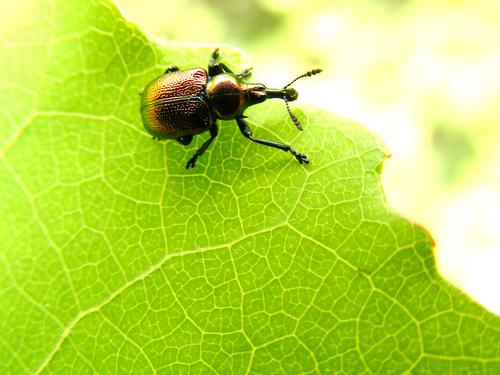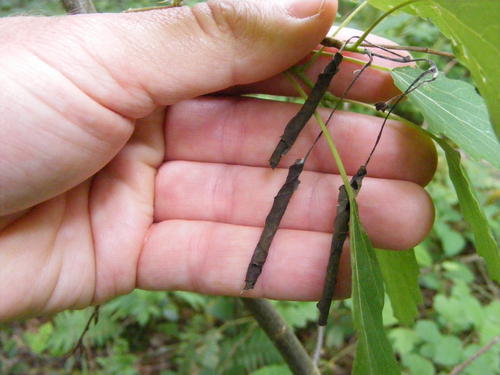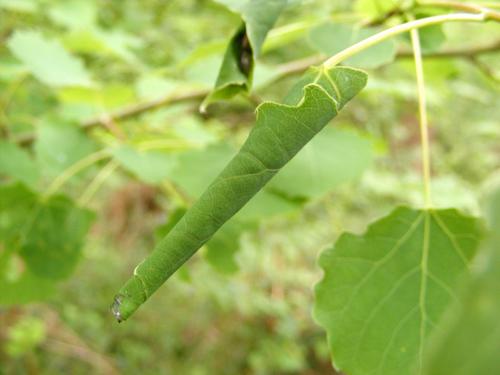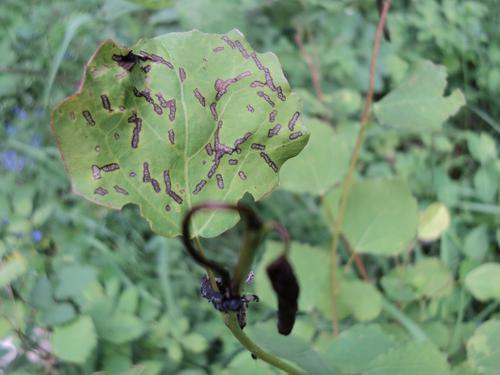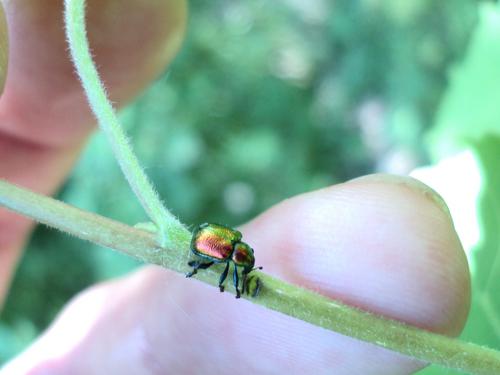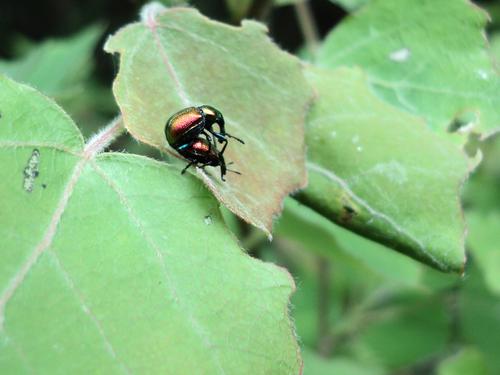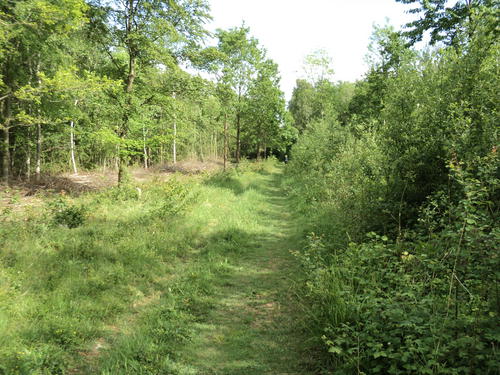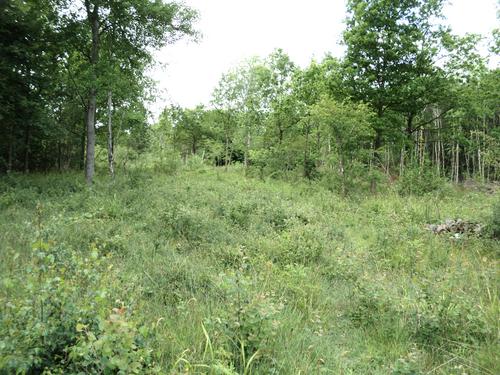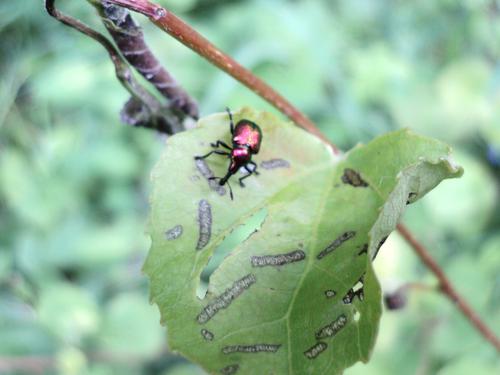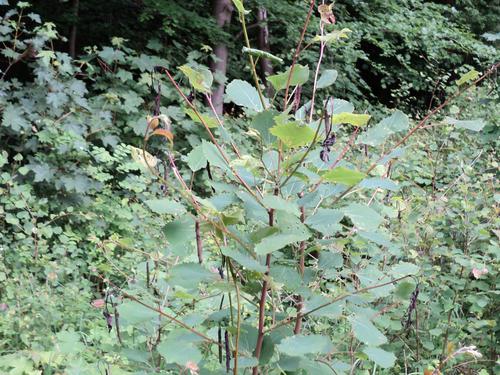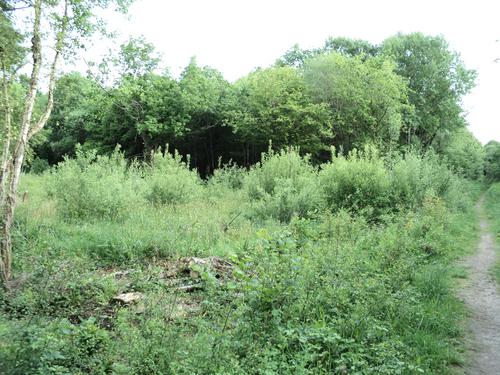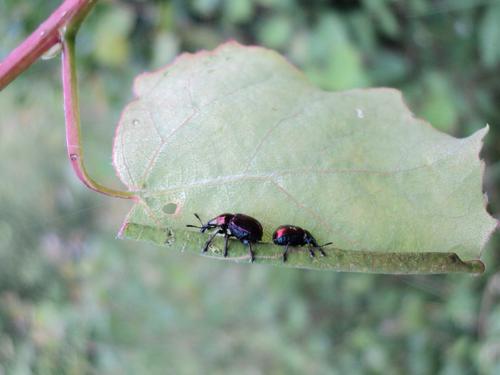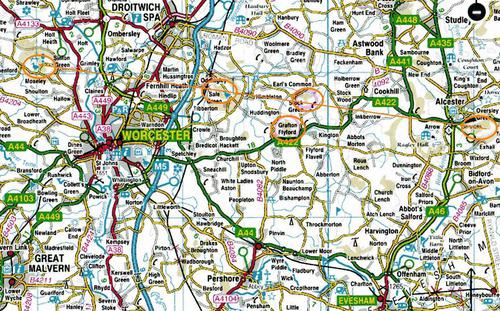The Aspen Leaf-rolling Weevil Byctiscus populi. An Update on its status, with particular reference to the Worcestershire Population
Steve Lane
Introduction
The leaf-rolling weevil Byctiscus populi is a striking green or coppery-metallic beetle around 5mm in length. It feeds on aspen Populus tremula in open woodland and scrub habitats and has a highly localised distribution in the UK.
Adults overwinter to emerge in early spring and to set about rolling the leaves of young aspen saplings, a process which is achieved in several stages. Firstly, the weevil nips the petiole of the leaf causing it to soften and darken. Once the leaf has wilted the female, sometimes assisted by other individuals, rolls the leaf into a thin cigar-shaped tube and deposits several eggs into this structure.
The leaf then naturally dies and falls off the plant to the ground. The larvae which have hatched from the eggs, feed on the decaying leaf tissue and then probably pupate in the ground to emerge as adults some weeks later.
It is likely that there are several generations throughout the year, adults being recorded in most months between May and October inclusive. However, late June is thought to be the season when activity peaks with both leaf rolls and adults at their most numerous.
Distribution
The aspen leaf rolling weevil is relatively common in central Europe (Harde, 1998), in contrast to its distribution in the UK. Hyman (1992) states that it used to be found throughout southern England with scattered records up into Norfolk, Gloucestershire and Worcestershire, however, in more recent times, it has declined dramatically and it is now known to survive at very few sites.
Outside of Worcestershire, since the 1990s, its presence has been confirmed from the Broxbourne Woods complex and Brickets Wood, in Hertfordshire, from Ham Street Woods and Orlestone Woods in Kent, from Ruislip Common in Middlesex, Backwardens Reserve at Danbury Common in Essex, Bookham and Wisley Commons in Surrey and from Oversley Wood in Warwickshire. The Surrey populations may have disappeared as there are no records since the early 1990s.
Because the species is known from so few localities in the UK and because of the overall population decline, it was awarded Red Data Book National Status (‘Rare’ – RDB3). It is also a National BAP (Biodiversity Action Plan) species for which a programme of conservation priorities exists.
Populations are vulnerable to habitat destruction and to changes in habitat that might occur as a consequence of insensitive woodland management or lack of management.
Surveying - What to Look For
Byctiscus populi may have been chosen as a National BAP species due to the ease with which its presence can be assessed and its population strength measured at a site.
Most people would assume that the most obvious way to determine whether the weevil is present would be to find adults. These are very distinctive and cannot be confused with any other British beetle species (Fig. 01.). They can be collected by sweeping or by beating aspens, but they are probably more easily found by searching leaves of suitable young plants. The weevil, although small, is usually quite easy to spot because of its bright metallic reflection.
If a population is highly localised or small, a much more reliable method is to search for leaf rolls. These usually take the form of narrow, tightly-rolled tubes which are often clustered towards the top of suitable aspen saplings and suckers (Fig. 02.).
At this point, you might feel that armed with this knowledge about leaf roll identification, you are ready to set out and find Byctiscus, but beware! To confuse the unwary beginner, another insect also rolls aspen leaves. This insect is a Gelechiid moth Anacampsis populella.
Fortunately, with a little practise, it is fairly easy to differentiate leaf rolls of the two species. The moth rolls usually remain green and they invariably sit at an angle that is more-or-less perpendicular to the main stem (Fig. 03.). These characteristics are due to the fact that the moth does not kill the leaf at any time before, during, or after the rolling process and the larvae develop in situ. On close examination of these leaf rolls, you can usually make out a number of silk strands that bind the external leaf edge to the main body of the roll. Additional pointers are that moth rolls are most often solitary and are relatively loosely rolled, particularly so at the junction of the leaf and its stem.
In comparison, weevil rolls are tightly rolled, hang vertically downwards, are usually dark brown in colour and are often in clusters. There are no obvious silk strand bindings either.
The least reliable indicator of Byctiscus is feeding damage. The weevil creates characteristic damage within the leaf tissue which has the appearance of elongate mottled scorch marks on the leaf surface (Fig. 04.). The width of the mark corresponds to the width of the weevil's rostrum because the insect's jaws are positioned at the very tip of this structure.
It is possible that other insects create similar feeding patterns on aspen leaves, but in the absence of other more immediate factors, feeding damage alone can act as a tentative indicator to the presence of the weevil at a site and merit future visits.
The 2011 Survey of Byctiscus populi in Warwickshire
In 2010, Butterfly Conservation, in partnership with Forest Enterprise, secured funding from the SITA Trust, to carry out an invertebrate habitat enhancement project at Oversley Wood.
This wood, situated close to Alcester, in south-west Warwickshire, occupies around 94 hectares, half of which is classified as plantation on ancient woodland sites (PAWS) and the other half as ancient semi-natural woodland. The wood was designated as a Wildlife Site in 2011.
Up until July 2011, I worked for an Ecological Consultancy and it was in this capacity that I and a colleague, Brian Laney, were contracted by Forest Enterprise to undertake a survey of Oversley Wood. This survey would assess the distribution and strength of the weevil population and propose a management regime to secure the species' future survival at the site.
To put the Oversley population into a broader geographical context, further sites within a 10km radius of the locality that contained aspen, were surveyed to look for evidence of the weevil. In addition, Worcestershire sites that had previously been visited by Jon Mellings (MSc. Thesis unpublished) were also visited by the team. The purpose of these visits was to compare the populations there with that at Oversley and by reference to the management carried out at these sites, to inform future management proposals at the Warwickshire site.
The 2011 survey at Oversley revealed a localised but viable population, with 132 leaf rolls and nine adults counted over a two day survey period. Although this is the highest count ever made at the site, it is believed that the population is in steady decline because the amount of suitable habitat is decreasing through conversion of habitat to high forest.
In common with Jon Melling’s observations in 2003, the weevil was found almost exclusively in the south-eastern section of the wood. Here, it is found on aspen saplings that are two years old or younger.
The south-east sector of the wood has a gentle south-east facing gradient and is sheltered from prevailing westerly winds by the conifer plantation on the plateau above. Woodland management here has produced scrub growth with varied age structure and aspen regeneration has been encouraged. The weevil evidently favours sunny, sheltered sites.
Visits to other sites in Warwickshire to search for the weevil were largely unproductive although one small area of woodland close to Oversley Wood contained some unprocessed leaf rolls (i.e. a number of leaves at the tips of the plants had been killed but not rolled) and possible signs of feeding damage. Similar observations were made at another site further north. These woods need to be revisited in 2012.
Byctiscus in Worcestershire
As far as Worcestershire is concerned, Mellings (MSc thesis, unpublished) referenced Trench Wood and Monk Wood in his investigation of Byctiscus in the UK. Both woods are owned and managed by Worcestershire Wildlife Trust in conjunction with Butterfly Conservation.
Trench Wood was cleared in the 1960s by Harris Brush, who replanted it to grow trees for broom heads. The wood was later purchased by Worcestershire Wildlife Trust financially assisted by Butterfly Conservation and is now managed to provide habitat diversity. Management aims to create open glades and clearings for invertebrates and plants.
James Hitchcock at the Worcestershire Wildlife Trust provided a great deal of information about management practices at this site. The main ride was widened in winter 2010/11 to promote regeneration of aspen (Fig. 07.), whilst scalloping of ride edge habitat is carried out on a four-year rotational basis. This localised, selective clearance creates a diversity of age structures in the tree canopy. The central woodland area is very open in aspect, with around a quarter of the area cut each year to maintain scrub habitat and large clearings (Fig. 08.).
On 19th May 2011, along with Brian Laney, I visited Monk Wood and Trench Wood in Worcestershire to look for the weevil and to assess the overall suitability of these woodland sites for the species.
That day will forever be etched in my memory as one of the most memorable fieldwork forays of my life. We first visited Trench Wood and we had hardly stepped out of the car when we came upon numerous leaf rolls and feeding damage in a small scalloped area off a subsidiary ride. When we reached the central open area of the wood, there were literally thousands of leaf rolls and an abundance of adult weevils. It seemed that the species had occupied every available aspen sapling and sucker. Absolutely astonishing!
In comparison with Oversley Wood, Trench Wood has an incredibly strong population of Byctiscus, due undoubtedly to the management regime implemented by the Wildlife Trust.
Monkwood has a similar history to Trench Wood. It was also owned by Harris Brush who cleared large areas from the 1950s onwards, to grow wood for broom handles. In 1986, the wood was purchased by the Worcestershire Wildlife Trust and Butterfly Conservation working in partnership and like Trench Wood, management is focussed on maximising habitat diversity and by creating open areas for invertebrates. Management here involves clearance at the rate of two half-acre coppice plots annually, on an 8-year rotation cycle.
The survey in 2011 found this wood to contain much less aspen than Trench Wood and our immediate impression was that it would not be suitable for Byctiscus. However, we did find the weevil in good numbers around the ponds, where recent management had significantly opened up the habitat (Fig. 11.). The weevil was also found in a small number of other locations. Its distribution at Monkwood is probably best described as highly localised but not threatened.
Compared to Trench Wood, Monkwood has a more mature canopy and greater shading of narrower rides. Oaks are a more dominant feature of this wood and they have to be maintained because of their importance in conserving the dormouse population. Willow and hazel also proliferate in recently coppiced areas whereas in Trench Wood, aspen would often dominate in a similar situation.
Where Jon Mellings located strong populations of Byctiscus at Monkwood in 2003, these areas have since deteriorated through maturation, becoming too heavily shaded.
Worcestershire must surely be the National stronghold for this weevil, both in terms of the number of localities where it is present and the strength of the populations at these sites. Byctiscus has long been known from Trench Wood NR and Monk Wood NR, but in the last decade, thanks to diligent searching by local enthusiasts, two further localities have emerged for this species in the form of Grafton and Roundhill Woods. The Grafton Wood population appears to be fairly well-established since it was first recorded about ten years ago. At Roundhill Wood, the picture is less clear and further survey work is required here to provide better information about the current status of the weevil.
One wonders just how many more sites there are in Worcestershire for this species.
Insect Ley-Lines? The Mystery Deepens [the editor take no responsibility for this diversion!]
Had John Michell, the author of The View Over Atlantis (1969) been alive today, he might have been interested in the Worcestershire/Warwickshire alignment of Byctiscus populi. Michell encouraged the belief that ancient sites were aligned and that these alignments, called “Ley Lines”, had some greater spiritual significance.
Well, perhaps I need to get out more, but I did happen to notice that the localities for Byctiscus populi (well, four of them at least) are aligned exactly on a straight line drawn through them from west to east (Fig. 13. – unlucky for some?). Grafton Wood unfortunately spoils the hypothesis by being a fraction too southerly – perhaps it previously occupied a much greater area to the north.
Maybe it would pay to look at other sites along this line between Aberystwyth and Ipswich just in case there are greater forces at work here than the force of nature. For the time being though, I think it best to pass this off as a coincidence. Besides, if you joined the dots on all of the UK sites, it would no longer be a straight line – but then again, how strange would it be if it perfectly described the outline of a suckering aspen leaf?
Conclusions
Trench Wood and to a lesser degree, Monkwood both provide ideal habitat for Byctiscus populi through rotational coppicing and clear-felling management strategies. At Trench Wood, where these practices have been more intensively and recently administered, the response of the leaf-rolling weevil has been dramatic. It is highly unlikely that any other site in the UK has such a prolific population.
A core concern for Worcestershire Wildlife Trust working in conjunction with Butterfly Conservation is habitat enhancement for Lepidoptera in these woods. However, it is a happy surprise that management to benefit butterflies also creates ideal conditions for Byctiscus populi to prosper, and no doubt countless other invertebrates. Not a bad outcome at all and one that Worcestershire Wildlife Trust should be understandably proud of!
Further Reading
Evans, L. 2001. A study on Byctiscus populi (L. 1758) (Attelabidae) in Latvia and implications for conservation management in the UK. Unpublished MSc. Project, University of Leeds.
Harde, K.W. and Severa, F. 1998. A Field Guide in Colour to Beetles. Leicester: Blitz Editions.
Hyman, P.S. and Parsons, M.S. 1992. A review of the scarce and threatened Coleoptera of Great Britain, Part 1. Peterborough: JNCC.
Mellings, Jon. 2002, Byctiscus populi:The status and biology of a rare species action plan (SAP) weevil in Worcestershire. Worcestershire Record 13:25-27.
Mellings, Jon. Habitat Preferences and Distribution In the Aspen Leaf-Rolling Weevil Byctiscus populi (L. 1758). MSc Project.
Mellings, J. and Compton, S. 2001 Byctiscus populi, a leaf rolling weevil dependent on Aspen. The Biodiversity and Management of Aspen woodlands: Proceedings of a one-day conference held in Kingussie, Scotland, on 25th May 2001 (transcript)
Morris, M.G. 1990. Handbooks for the identification of British insects volume 5, part 16. Orthocerus weevils, Coleoptera Curculionoidea (Nemonychidae, Anthribidae, Urodontidae, Attelabidae and Apionidae) 1st ed., London: Royal Entomological Society.
Morris, M.G. 1999. Byctiscus populi (a leaf-rolling weevil) Action plan. In UK Biodiveristy Group Tranche 2 Action Plans, Vol 5: Invertebrates (March 1999). Peterborough: JNCC.
Oversley Wood Forest Design Plan. 2003-2013. West Midlands Forest District, Forest Enterprise (CD-Rom)
McGee, K. 2001. Records of note 2001. Worcestershire Record 11:27-11. (Reported Byctiscus populi from Monkwood in 2001).
Images
Fig. 01. Adult Byctiscus populi. ©Steve Lane
Fig. 02. Byctiscus populi leaf rolls on aspen sapling. ©Steve Lane
Fig. 03. Leaf roll of Gelechiid moth Anacampsis populella on aspen. ©Steve Lane
Fig. 04. Byctiscus populi feeding damage on aspen leaf. ©Steve Lane
Fig. 05. Adult Byctiscus populi nipping petiole to kill leaves above. ©Steve Lane
Fig. 06. Byctiscus populi adults in copulation. ©Steve Lane
Fig. 07. Widened main ride at Trench Wood. ©Steve Lane
Fig. 08. Open central glade at Trench Wood. ©Steve Lane
Fig. 09. Byctiscus populi adult feeding. ©Steve Lane
Fig. 10. Leaf rolls on suckering aspen at Trench Wood. ©Steve Lane
Fig. 11. Cleared area near ponds at Monkwood. ©Steve Lane
Fig. 12. Two adult Byctiscus populi rolling aspen leaf at Monkwood. ©Steve Lane
Fig. 13. Map to show the Bytiscus populi east-west alignment of sites. Steve Lane
